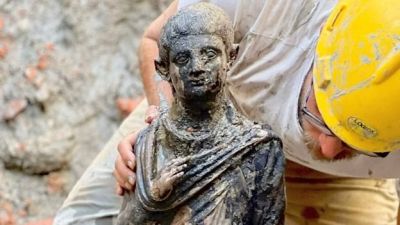Italian archaeologists have unearthed 24 beautifully preserved bronze statues in Tuscany believed to date back to ancient Roman times. The statues were discovered under the muddy ruins of an ancient bathhouse in San Casciano dei Bagni, a hilltop town in the Siena province, about 100 miles north of the capital Rome. Depicting Hygieia, Apollo and other Greco-Roman gods, the figures are said to be around 2,300 years old. One expert said the find could "rewrite history". Most of the statues, which were found submerged beneath the baths alongside around 6,000 bronze, silver and gold coins, date to between the 2nc Century BC and the 1st Century AD. The era marked a period of "great transformation in ancient Tuscany" as the area transitioned from Etruscan to Roman rule, the Italian culture ministry said. The statues, which were preserved by the water, will be taken to a restoration laboratory in nearby Grosseto, before eventually being put on display in a new museum in San Casciano.
Gli archeologi hanno estratto ventiquattro bellissime statue fatte in bronzo in Toscana. Pensano che le statue siano del periodo dell'antica Roma. Le statue si trovavano sotto le rovine di un bagno pubblico a San Casciano dei Bagni, un villaggio nelle colline in provincia di Siena, a circa 160 chilometri a nord di Roma. Le statue rappresentano i nomi di divenità greche come Apollo e Igea. Le statue devono avere circa 2.300 anni. Un esperto ha dichiarato che le statue possono "riscrivere la storia". Oltre alle statue, gli archeologi hanno ritrovato 6.000 monete di bronzo, argento e oro. Le monete possono essere datate tra il II secolo a.C. e I secolo d.C. Secondo il Ministero della Cultura Italiana, quest'epoca fu durante "una grande trasformazione nell'antica Toscana" quando l'area passò dal regno estrusco a quello romano. Le statue sono state preservate dall'acqua. Le statue saranno portate in un laboratorio di Grosseto prima di essere esposte in un museo a San Casciano.



